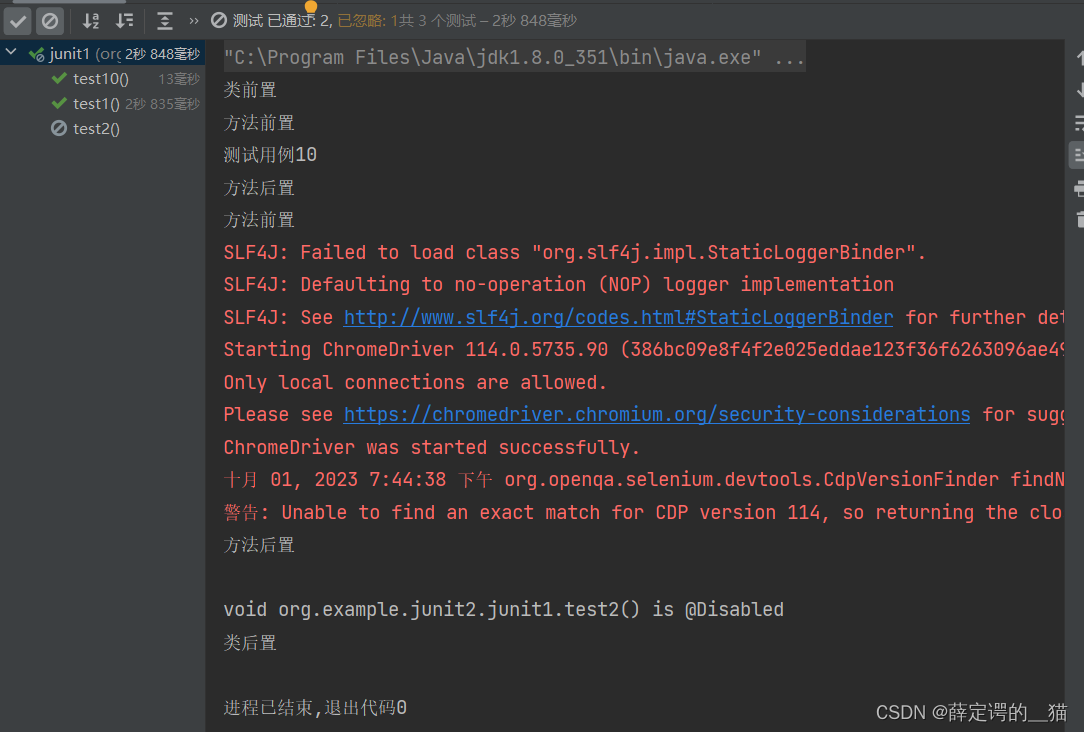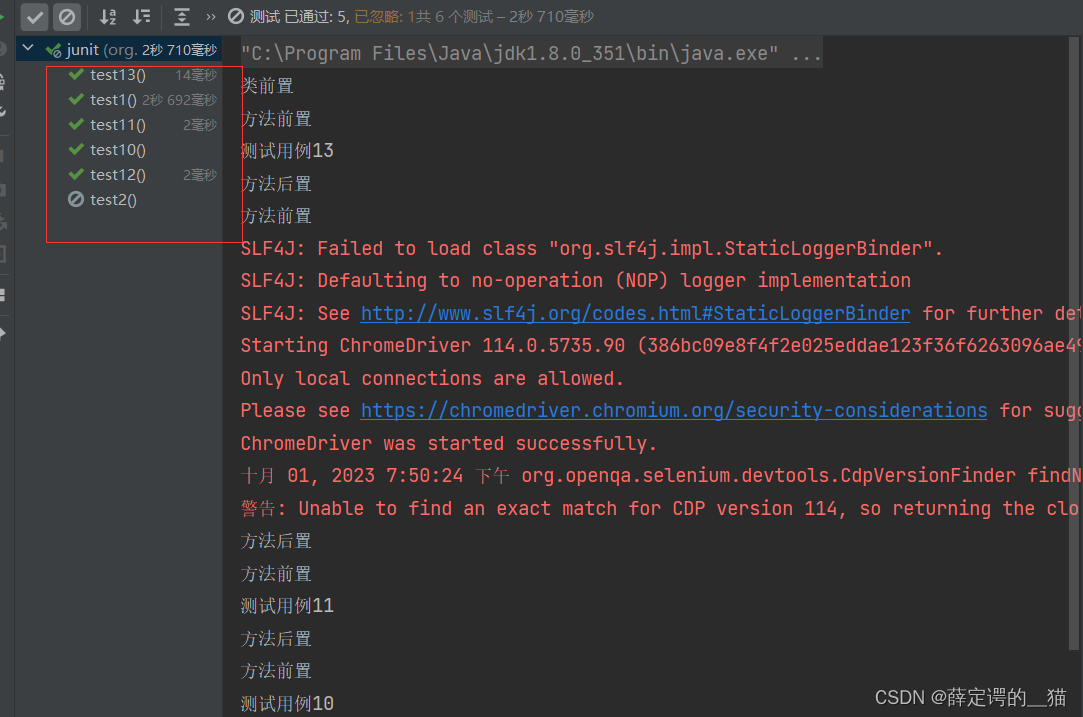注:本篇文章讲解的是junit5
目录
Juint是什么
Juint需要导入的依赖
Juint常用注解
Junit执行顺序
参数化
断言
测试套件
Juint是什么
Juint 是 Java 的一个单元测试框架. 也是回归测试框架. 使用 Junit 能让我们快速的完成单元测试。
注意:Junit 测试也是程序员测试,即白盒测试,它需要程序员知道被测试的代码如何完成功能,以及完成什么样的功能
Juint需要导入的依赖
本篇文章junit代码需要的依赖, 这里给大家贴出来
<!--junit依赖-->
<!-- api--><!-- https://mvnrepository.com/artifact/org.junit.jupiter/junit-jupiter-api --><dependency><groupId>org.junit.jupiter</groupId><artifactId>junit-jupiter-api</artifactId><version>5.9.2</version></dependency><!-- 参数化需要的--><!-- https://mvnrepository.com/artifact/org.junit.jupiter/junit-jupiter-params --><dependency><groupId>org.junit.jupiter</groupId><artifactId>junit-jupiter-params</artifactId><version>5.9.2</version></dependency><!-- 测试套件--><!-- https://mvnrepository.com/artifact/org.junit.platform/junit-platform-suite --><dependency><groupId>org.junit.platform</groupId><artifactId>junit-platform-suite</artifactId><version>1.9.2</version></dependency><!-- 测试套件--><!-- https://mvnrepository.com/artifact/org.junit.jupiter/junit-jupiter-engine --><dependency><groupId>org.junit.jupiter</groupId><artifactId>junit-jupiter-engine</artifactId><version>5.9.2</version></dependency>
Juint常用注解
@Test: 在类上注解,i表名当前类是一个测试用例
@BeforeAll: 一个类中,所有方法执行之前会执行一次
@AfterAll: 一个类中,所有方法执行结束会执行一次
@BeforeEach: 每个方法执行执行都会执行一次这个方法
@AfterEach: 每个方法执行结束之后都会执行一次这个方法
@BeforeAll @AfterAll 与 @BeforeEach @AfterEach 区别在于
@BeforeAll @AfterAll
修饰的方法是static void的,也就是说是属于类的,在一个类中一共只会执行一次
@BeforeEach @AfterEach
修饰的方法是void的,会在类中的每个方法执行 之前/之后 都会执行一次
还有一个常用方法是:
@Disabled: 忽略当前测试用例,不执行
public class junit1 {@Testvoid test1(){WebDriver webDriver=new ChromeDriver();webDriver.get("https://www.baidu.com/");}@Disabled //忽略当前测试用例,不执行@Testvoid test2(){System.out.println("测试用例2");}@Testvoid test10(){System.out.println("测试用例10");}@BeforeAllstatic void test3(){System.out.println("类前置");}@AfterAllstatic void test4(){System.out.println("类后置");}@BeforeEachvoid test5(){System.out.println("方法前置");}@AfterEachvoid test6(){System.out.println("方法后置");}}通过这个执行结果也可以清晰的看到执行的顺序 以及执行的次数

Junit执行顺序
那么如果方法多了,哪个方法优先执行呢?
默认顺序由方法名hashcode值来决定,如果hash值大小一致,则按名字的字典顺序确定
由于hashcode的生成和操作系统相关(以native修饰),所以对于不同操作系统,可能会出现不一样的执行顺序,在某一操作系统上,多次执行的顺序不变.
我们也可以进行设置:
设置有两种方式:按照指定顺序执行 / 按照随机顺序执行,不可以同时存在
//声明按照指定顺序进行执行
@TestMethodOrder(MethodOrderer.OrderAnnotation.class)
//随机顺序执行
//@TestInstance(MethodOrderer.Random.class)//不可以同时存在
public class junit {@Order(2)@Testvoid test1(){WebDriver webDriver=new ChromeDriver();webDriver.get("https://www.baidu.com/");}@Disabled //忽略当前测试用例,不执行@Testvoid test2(){System.out.println("测试用例2");}@Order(5)@Testvoid test10(){System.out.println("测试用例10");}@Order(4)@Testvoid test11(){System.out.println("测试用例11");}@Order(8)@Testvoid test12(){System.out.println("测试用例12");}@Order(1)@Testvoid test13(){System.out.println("测试用例13");}@BeforeAllstatic void test3(){System.out.println("类前置");}@AfterAllstatic void test4(){System.out.println("类后置");}@BeforeEachvoid test5(){System.out.println("方法前置");}@AfterEachvoid test6(){System.out.println("方法后置");}}
执行结果就是按照我们设置的顺序进行执行的, 设置的数字顺序可以不连续, 可以为负数,
他会按照从小到大的顺序进行执行:

参数化
单参数
多参数: 1. cvs 传参 2. 方法传参
//参数传递
public class junit2 {public static Stream<Arguments> m1() {return Stream.of(Arguments.arguments("1,zhang","2,lissss","3,wang","4,lisi"));}//单参数// @Test@ParameterizedTest//不可以和Test同时存在@ValueSource(strings = {"1","2","3"})void test10(String str){System.out.println(str);}//多参数 Csv1@ParameterizedTest@CsvSource({"1,2","s,3"})void test(String s,int n){System.out.println(s+" "+n);}//多参数 Csv2@ParameterizedTest@CsvFileSource(resources="test1.csv")void test2(int id,String name){System.out.println(id+" " +name);}//使用方法进行多参数传递@ParameterizedTest@MethodSource("m1")void test3(String id,String name){System.out.println(id+" "+name);}}
断言
//断言@ParameterizedTest@ValueSource(strings={"1"})void test4(String s){//断言相等Assertions.assertEquals(s,"1");//断言不相等Assertions.assertNotEquals(s,2);//断言为空Assertions.assertNull(s);//断言不为空Assertions.assertNotNull(s);}测试套件
Junit是怎么进行管理测试用例的呢?
就是通过测试套件.
1.以类为单位进行执行
@Suite
@SelectClasses({junit.class,junit2.class})
public class suit1 {
}
2.以包为单位进行执行
@Suite
@SelectPackages({"org.example.junit1","org.example.junit2"})
public class suit1 {})

)

)






![[C++随想录] 优先级队列的模拟实现](http://pic.xiahunao.cn/[C++随想录] 优先级队列的模拟实现)
笔记)






